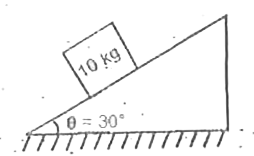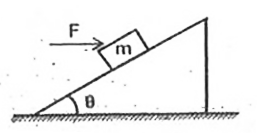Two blocks A and B of same masses are resting in equilibrium on an inclined plane having inclination with horizontal =α(>0). The blocks are touching and exerting no zero normal force on each other with block B higher than A. Coeffcient of static friction of A with incline =1.2 and of B=0.8. If motion is not imminent
α>30∘
(Friction)A>(Friction)B
α>45∘
(Friction)A=(Friction)B
The correct Answer is:B, C
To solve the problem, we need to analyze the forces acting on the two blocks A and B resting on the inclined plane. Here are the steps to arrive at the solution:
Step 1: Identify the Forces Acting on Each Block
For both blocks A and B, the forces acting on them include:
- The weight of the blocks W=mg acting downwards.
- The normal force N acting perpendicular to the inclined plane.
- The frictional force Ff acting parallel to the inclined plane, opposing the motion.
Step 2: Break Down the Weight into Components
The weight can be resolved into two components:
- Perpendicular to the incline: Wcosα
- Parallel to the incline: Wsinα
Step 3: Determine the Normal Force
For both blocks, the normal force N is equal to the perpendicular component of their weight:
N=Wcosα
Step 4: Calculate the Frictional Forces
The frictional force for each block can be calculated using the formula:
Ff=μN
Where μ is the coefficient of static friction.
For block A:
FfA=μAN=1.2×Wcosα
For block B:
FfB=μBN=0.8×Wcosα
Step 5: Analyze the Condition for Equilibrium
Since the blocks are in equilibrium and motion is not imminent, the frictional force must be greater than or equal to the component of weight acting down the incline.
For block B:
FfB≥Wsinα
Substituting the expression for FfB:
0.8Wcosα≥Wsinα
Step 6: Simplify the Inequality
Dividing both sides by W (assuming W≠0):
0.8cosα≥sinα
Step 7: Rearranging the Inequality
Rearranging gives:
sinαcosα≤0.8
This can be rewritten as:
tanα≤0.8
Step 8: Determine the Range of α
To find the angle α, we can use the arctangent function:
α≤tan−1(0.8)
Step 9: Analyze the Options
Now, we check the options given in the question:
- Option A: α>30∘ (This is valid since tan(30∘)≈0.577)
- Option B: Not specified.
- Option C: α>45∘ (This is invalid since tan(45∘)=1)
- Option D: Not specified.
Conclusion
From the analysis, we conclude that:
- The condition tanα≤0.8 implies that α must be less than tan−1(0.8) which is approximately 38.66∘. Therefore, α cannot be greater than 45∘.
Thus, the correct options based on the analysis are:
- Option A is valid.
- Option C is invalid.
For both blocks A and B, the forces acting on them include:
- The weight of the blocks W=mg acting downwards.
- The normal force N acting perpendicular to the inclined plane.
- The frictional force Ff acting parallel to the inclined plane, opposing the motion.
The weight can be resolved into two components:
- Perpendicular to the incline: Wcosα
- Parallel to the incline: Wsinα
For both blocks, the normal force N is equal to the perpendicular component of their weight:
N=Wcosα
The frictional force for each block can be calculated using the formula:
Ff=μN
Where μ is the coefficient of static friction.
FfA=μAN=1.2×Wcosα
FfB=μBN=0.8×Wcosα
Since the blocks are in equilibrium and motion is not imminent, the frictional force must be greater than or equal to the component of weight acting down the incline.
FfB≥Wsinα
Substituting the expression for FfB:
0.8Wcosα≥Wsinα
Dividing both sides by W (assuming W≠0):
0.8cosα≥sinα
Rearranging gives:
sinαcosα≤0.8
This can be rewritten as:
tanα≤0.8
To find the angle α, we can use the arctangent function:
α≤tan−1(0.8)
Now, we check the options given in the question:
- Option A: α>30∘ (This is valid since tan(30∘)≈0.577)
- Option B: Not specified.
- Option C: α>45∘ (This is invalid since tan(45∘)=1)
- Option D: Not specified.
From the analysis, we conclude that:
- The condition tanα≤0.8 implies that α must be less than tan−1(0.8) which is approximately 38.66∘. Therefore, α cannot be greater than 45∘.
- Option A is valid.
- Option C is invalid.
Similar Questions
A block of mass m is placed on a smooth inclined plane of inclination θ with the horizontal. The force exerted by the plane on the block has a magnitude
View SolutionA block of mass m is placed on a smooth inclined plane of inclination θ with the horizontal. The force exerted by the plane on the block has a magnitude
View Solution
Knowledge Check
- Question 1 - Select One
A block of mass 2kg rests on a rough inclined plane making an angle of 30∘ with the horizontal. The coefficient of static friction between the block and the plane is 0.7. The frictional force on the block is
A10.3NB23.8NC11.9ND6.3N - Question 2 - Select One
A block of mass 3 kg rests on a rough inclined plane making an angle of 30∘. With the horizontal. The coefficient of static friction between the block and the plane is 0.7. The frictional force on the block is
A9.8 NB0.7×9.8×√3 NC9.8×√3 ND0.7×9.8 N
A block of mass 2kg rests on a rough inclined plane making an angle of 30∘ with the horizontal. The coefficient of static friction between the block and the plane is 0.7. The frictional force on the block is
View SolutionA block of mass 10 kg is kept on a fixed rough (μ=0.8) inclined plane of angle of inclination 30∘. The frictional force acting on the block is
 View Solution
View SolutionA block of mass 2 kg rests on a rough inclined plane making an angle of 30° with the horizontal. If μS=0.6 , what is the frictional force on the block ?
View SolutionA block is at rest on an inclined plane making an angle α with the horizontal. As the angle of the incline is increased the block start slipping when the angle of inclination becomes θ then coefficient of friction is equal to
View SolutionA body is placed on a rough inclined plane of inclination θ. As the angle θ is the increased from 0∘ to 90∘, the normal force between the block and the plane is,
 View Solution
View SolutionA block of mass m is at rest on a rough inclined plane of angle of inclination θ. If coefficient of friction between the block and the inclined plane is μ, then the minimum value of force along the plane required to move the block on the plane is
View Solution

